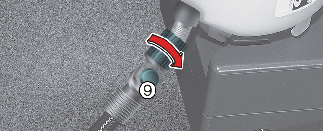Using the Tire Mobility Kit

Detach the speed restriction label from the sealant bottle, and place it in a highly visible place inside the vehicle such as on the steering wheel to remind the driver not to drive too fast.

-
Shake the sealant bottle.

-
Screw connection hose (10) onto the connector of the sealant bottle.
-
Ensure that button (9) on the compressor is not pressed.

-
Unscrew the valve cap from the valve of the defective wheel and screw the filling hose (3) of the sealant bottle onto the valve.

 CAUTION
CAUTIONSecurely install the sealant filling hose to the valve. If not, sealant may flow backward, possibly clogging the filling hose.
-
Insert the sealant bottle into the housing (5) of the compressor so that the bottle is upright.

-
Ensure that the compressor is switched off, position 0.
-
Connect between compressor and the vehicle power outlet using the cable and connectors (4).

 CAUTION
CAUTIONDo not connect another vehicle's Tire Mobility Kit (TMK) to the power outlet or battery terminal. The unmatched power requirement between the vehicle power outlet and the tire mobility kit can cause fire or circuit damage within the vehicle and the Tire Mobility Kit.
-
With the ENGINE START/STOP button position on or ignition switch position on, switch on the compressor and let it run for approximately 5~7 minutes to fill the sealant up to proper pressure. (refer to More Details). The inflation pressure of the tire after filling is unimportant and will be checked/corrected later. Be careful not to overinflate the tire and stay away from the tire when filling it.
When the tire and wheel are damaged, do not use Tire Mobility Kit for your safety.
-
Switch off the compressor.
-
Detach the hoses from the sealant bottle connector and from the tire valve.
Return the Tire Mobility Kit to its storage location in the vehicle.

Tire pressure
Do not attempt to drive your vehicle if the tire pressure is below 200 kPa (29 psi). This could result in an accident due to sudden tire failure.

Carbon monoxide
Do not leave your vehicle running in a poorly ventilated area for extended periods of time. Carbon monoxide poisoning and suffocation can occur.